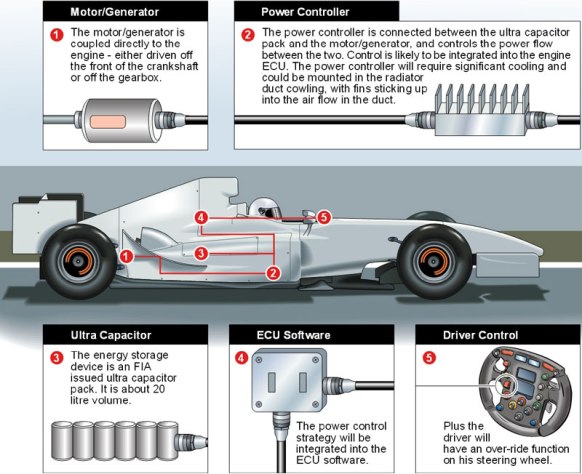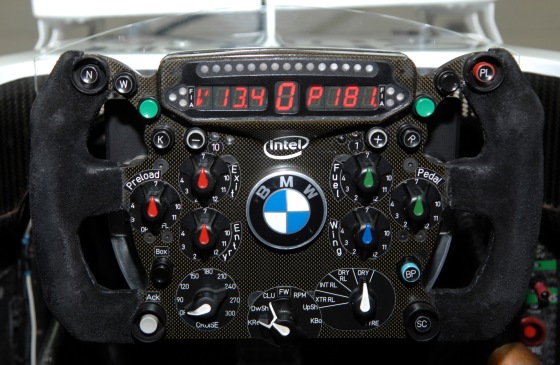A thankyou to the Redbull F1 team for providing some amazing open source videos!
KERS System Layout
When any vehicle driver wants to decelerate from a certain velocity and attain a comparatively lower velocity, the driver applies the brakes fitted on the car for exactly that purpose. The brakes help bring the speed of the vehicle down to the speed the driver desires by using the concept of friction.
Friction:
It is the resistance or the retarding force that the surface of an object encounters when moving over another surface.
Newton’s Law of conservation and energy states that energy cannot be created or destroyed. It can only be converted from one form to another. The deceleration of the vehicle in this case is thus an energy that is converted into heat energy at the point of contact between the brake disc & the brake calipers.
Braking in sports car produces upwards of 700 degrees C. They heat up and glow!
To sum it up:
Braking===Friction===Deceleration===Heat Energy at Brake Assembly===Heat dissipated to the surroundings===Heat Energy transferred & absorbed by surroundings===Brake Assembly Cooled.
What we should Realize:
A fuel-operated internal combustion engine efficiency even in today’s world is just about 35%.
This means a considerable amount of energy is lost due to various inefficiencies in the vehicle system. Heat loss due to heat dissipation from various components is one of the major contributors to reduced vehicle efficiency!
Now that the basics are covered:
KERS (Kinetic Energy Recovery System) used in Formula 1 Racing Cars
This is a method of recovering energy that is lost due to the generation of heat during braking and converting it into useful energy to be used at a later stage (mostly during acceleration) by eliminating the entire “regular” brake assembly and replacing it with two 80HP (60KW) motors which are fitted in direct mesh with the driving wheels.
So now instead of a brake disc and brake calipers there is a system containing two 80HP electric motor/generators in their place. The type of motors used in some cases is High Voltage Hairpin Motors.
High Voltage Remy Hairpin Motor
The entire assembly weighs in at just around 60 pounds i.e. about 28kg. This keeps the overall weight of the car really low.
Working:
Condition 1:
- The car comes to a corner at speeds at over 300kmph.
- The driver has to decelerate.
- He uses the brakes which in this case activate the Electric Motor/Generator.
Condition 2
- During deceleration the Electric Motors act as Generators.
- Thus they help converting rotational energy into electrical energy, effectively using the reduction of kinetic energy in producing useful electrical energy/rotational energy.
Condition 3:
- Electrical energy generated is stored in super-capacitors which is one form of KERS.
- Rotational energy is stored in a flywheel-motor designed out of light-weight composite materials and mounted on ceramic bearings to reduce friction during rotation.
- These flywheels rotate at 30,000-40,000rpm!
- These energy storage devices can store the energy generated for a reasonable period of time.
Condition 4:
- This is when the magic happens! The driver pushes a button on the steering wheel which releases the energy stored in the KERS flywheel-motor or super-capacitors.
- This energy is now reconverted into electrical energy and is resupplied to the two 80HP electric motors coupled to the driving wheels.
- This translates to a raw 160HP power generated for 7-8seconds in addition to engine power.
Condition 5:
The car accelerates really fast and possibly overtakes it’s opponent.
The whole system is termed as fast charge-fast discharge system basically because of the speed in which electricity can be produced and reused to do useful work.
Your typical F1 Steering wheel. Costs about $50,000. Guess where the KERS button is???
Why I call this a Green technology is because it’s potential as a device that increases the overall efficiency of a modern car is tremendous.
That is the basic goal of Formula 1 racing. It allows developers and designers to think out-of-the-box and develop new technologies that further the advancement in automobile technologies. It helps the companies involved in racing to use these technologies with the hope that these new inventions may one day come down to the cars that we buy thus helping cars become more than what they were before!
The funny part about KERS is that it was so amazing a technology that every racing team out there started developing and using it in their F1 cars which made their cars have this insane power advantage at all times. This was seen as a major problem by the F1 Rules & Regulations Board. Though the F1 regulators did not ban this technology, the companies came to a mutual agreement to do without it and stick to regular racing!
More amazing F1 technologies that are used currently & some that are banned will be posted in the course of time. I need to make sure that I can do justice to the technology and that takes time!
So stay tuned and I’ll keep you all posted!
>vrroooooooom<
A detailed explanation on KERS



